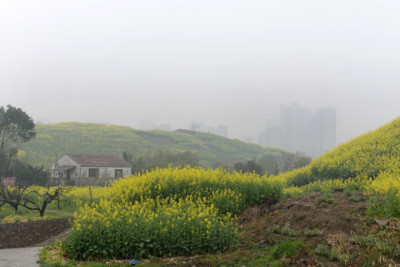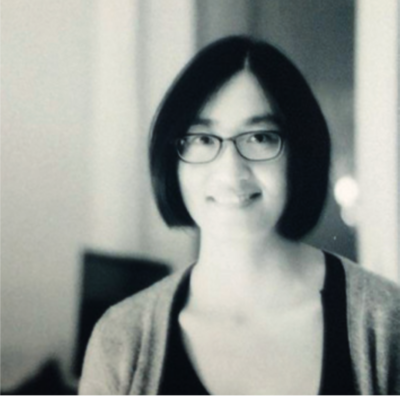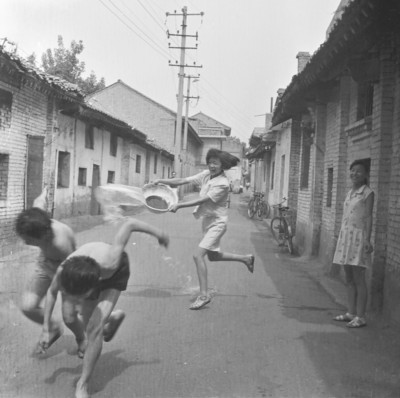During the three-day symposium – organized by Aedes Architecture Forum Berlin, Songyang County Government & Aedes Network Campus Berlin – that took place from November, 8th to 10th 2018, international experts gathered in Songyang county in Zhejiang Province in China to discuss and share experiences on the topic of „global rural region“ as well as visiting the projects and examples designed by architect XU Tiantian, who implemented more than ten projects in Songyang with the idea of „architectural acupuncture“.
Altogether 56 international guests and 143 guests from China attended the conference including 28 invited speakers. The conference took a 360-degree approach, in which speakers from various professions were invited, including politicians, architects, economists, policy makers in cultural heritage and tourism, university professors, directors of museums and foundations, as well as international policy makers, practitioners and coordinators. The conference took place in the town centre of Songyang. The main venue was the Tanglan Guild Hall that used to be a Guanyu Temple, with a branch venue at the Wood Club, which was facilitated with a screen for a synchronized broadcasting. Due to the dense conference schedule, there was little time left for question-and-answer sessions, open discussions or a more direct interaction with and hearing of the local residents.
At the opening of the symposium, following words of welcome from the magistrate Mr. LI Hanqin and the party secretary Mr. WANG Jun as the hosts from Songyang, Ms. Kristin Feireiss, director of Aedes Architecture Forum Berlin as initiator of the event, reflected on the gallery’s constant efforts since the 1990s to introduce the architecture scene in China, emphasized the role of architecture in “the transformation process of society” and suggested seeing „rural region as a global issue“.
Dr. Remy Sietchiping, leader of regional and metropolitan planning at UN-HABITAT in Kenya, gave a keynote speech, in which he pointed out that the disparity of urban and rural household incomes has risen to ever new highs ever since the 1990s. He mentioned the importance of “balanced territorial development” in the process of urbanization as well as the importance of “strategy and program“ in the transformation process. He raised the problem in the urbanization process in China that the cities are absorbing the villages while the villages grow bigger and saw new opportunities in the booming E-Commerce in China. He also gave a review of the four stages of the urban-rural linkage in China. From 1949-1977, labour mobility was strictly controlled and the rural sector subsidized the urban sector, leading to a policy-forced urban-rural cleavage. Between 1978 and 2000, due to the reform policy started in 1978, the urban-rural interface became market driven; cheap rural labour flooded into cities for jobs but gained little access to urban services due to the hukou (户口) constraints. The years between 2001 and 2012 saw a land-driven urban-rural tension, where rural land was rapidly converted into urban use on a large scale through state expropriation. From 2013 onwards, an urban-rural integration policy was attempted and welfare improvements for the rural population and migrant workers came into focus, including the discussion of the hukou-system and taxation reform with the proposal to introduce a property tax; especially since 2014, China’s leadership has outlined a new form of urbanization that calls for a balanced development with a focus on urban-rural coordination. Dr. Sietchiping emphasized the importance of the protection of cultural and national heritage and supported the idea of „good tourism“. As an outlook, a global partnership for urban-rural linkage and the set-up of international guidelines on urban and territorial planning were seen as a recent trend. In terms of guidelines, he mentioned in another interview the UN approach in international collaboration to avoid speaking of „DON’Ts” but to say „We suggest“ instead.
On November 9th, during the introduction speeches, Mr. Hans-Jürgen Commerell, director of Aedes Network Campus Berlin, told the story how Aedes got introduced to Songyang through the architect ZHANG Ke; the architect XU Tiantian talked about the role of architects and spoke of the economic, social and natural aspects of sustainability; Dr. Eduard Kögel, curator of Aedes Berlin, spoke of the phenomenon of growing centres and shrinking regions and the challenge of the increasing loss of diversity, with the suggestion to focus on the regional context. The chairman of the China Cultural Relics Protection Foundation, Mr. LI Xiaojie, introduced the “Rescue Old House Action“, through which 142 old houses got renovated through a joint funding of the government and the property owners. He expressed his hope that the Songyang story will set an example for and be introduced to more than 2,000 similar counties all over China. The party secretary and director of the State Administration of Cultural Heritage, Mr. LIU Yuzhu, suggested extending the categories of cultural heritage further to support private properties and relics of lower protection value. He also mentioned the advantages of such renovation projects: they can be done at lower costs since they are not subjected to a tendering process and they moreover help to train local craftsmen. He also supported reactivating properties of cultural heritage with new usage concepts.
Ten practitioners from all over the world including well-known reward winning Chinese architects were invited to give short talks in the format of so-called ten by ten impulse statements with a short overview of their own practices. Mr. ZHANG Ke presented his renovation concept focusing on materiality, for example by mixing Chinese ink into concrete to create a special texture. At the end of his speech he touched on the problem of decreasing arable land, suggesting to increase central density to save land for agriculture. Mr. ZHANG Lei emphasized a different relationship between the architect and client in the countryside, namely as co-operators. Mr. ZHU Jingxiang showed his projects of lightweight fast-build assembly architecture with an adjustable modular strategy to suit various climate and geographical environments, as solutions for quick after-crisis reconstruction and for poor remote regions. Prof. Hitoshi Abe spoke of Japanese concepts such as “domestic urbanism” and his experiences with wholesale districts and warehouse events. From the perspective of a museum director, Ms. Angelika Fitz from the Austrian Architecture Museum in Vienna spoke of the idea of using architecture to create centers.
She suggested switching from the concept of „participation“ to „co-production“ and mentioned the Austrian approach to „care and repair“ the built environment taking into consideration critical concept-duos of „ecology and economy“, „bottom-up and top-down“ and „local and global“.
Mr. Farrokh Derakhshani, director of the Aga Khan Award for Architecture raised the question of how to define „the rural“. He emphasized the importance of showing good examples and talked about five criteria: continuing traditional methods, elaborating local know-how, enabling participation and self-reliance, making replicable models and creating institutions as models.
The director of the Swiss Architecture Museum in Basel, Andreas Ruby, moderated a panel discussion with the theme of „ Culture and Architecture” and raised the question whether culture is a term that rather belongs to the cities, whether rural areas will become so successful with the „Bilbao Effect“ that they actually become cities, and what would the prototyping of a successful Songyang story mean to Chinese cities. He reflected on the two visions of urbanization modes: either generating more concentrated density or a decentralized total urbanization; through these questions he suggested envisioning and foreseeing possible consequences for the cities as the countryside increasingly becomes the development focus: “What about workdays in the countryside, weekends in the city“, he asked. At the panel discussion, Hitoshi Abe spoke for facilities and programs for the young generation to take up rural lives in the countryside; Farrokh Derakhshani saw the value in rural development in how to give more choices to people to choose the way they want to live; LI Xiangning, curator of the Chinese Pavilion at the Venice Biennale 2018, doubted that the Songyang story will become a prototype for rural development. According to him, it depends very much on the architect and even more on the politicians. In a later interview he also differentiated two types of rural areas – those like Songyang which have an obvious development advantage with cultural heritage and agricultural specialties, and those which are extremely remote and poor and lack resources.
The program on November 10th focused on the topic of „Ecology, Economy and Architecture“. Prof. LIU Shouying from the School of Economics of Renmin University of China spoke of the problem that the hinterland in China tended to imitate the urban and coastal development modes through intensive construction activities which has led to the phenomenon of “ghost cities“. He reviewed the industrialization process since the 1950s and suggested reforms and a redefinition of agriculture and a revitalization of the peasants as citizens. In the panel discussion moderated by Mr. Aric Chen from Hongkong, Prof. LIU emphasized the importance to integrate the inherent texture and logic of the countryside with elements from the urban outside; he placed „replicable models“ and specific approaches against each other and generally doubted the replicability of models. Instead, he favours the examination of diverse and basic conditions and suggested a clear division of the boundary between policy and market. During the panel discussion, Prof. Erhard An-He Kinzelbach from Bochum University of Applied Sciences suggested focusing on both the hardware and the software of development in providing solutions of contemporary dwelling. Nuria Costa Leonardo from the Mexican Women’s Network also argued for a more integrated and more thorough approach to look at infrastructures and ecological systems concerning practical issues like water preservation, recycling, pollution reduction etc., instead of solely focusing on restoring building structures. A similar view was expressed by Juan Mayr Maldonado, National Commission for Conciliation from Colombia, who gave an introduction to the case in Colombia where land for indigenous people was recovered in the 1980s, suggesting to regard buildings not as isolated bodies but as a system. He added the spiritual level to the current discussion on environmental, social and economical levels, compared the differences of lowland and highland areas and asked questions such as: what is the soul of the buildings, what is architecture of culture with the focus on identities, and what is architecture of nature?
Beside the speeches and panel discussions, excursions to the various building sites were organized, including several projects designed by the architect XU Tiantian. With her concept of “architectural acupuncture”, she tried to find a special topic for each individual village and designed buildings that embody exactly these topics, providing various solutions in various cases.
The Brown Sugar Factory for example has become a place to showcase the local traditional production of brown sugar in Xing Village. It helps to raise the peasants’ revenues through tourism while providing a place for community activities at production-free seasons.
A similar approach to showcase local products is seen at the Tofu workshop where Tofu is produced in front of visitors’ eyes. The Indenture Museum explores the material „stone“. Due to the anticipated popularity of the museum, places for homestay, workshops and restaurants in the adjacent areas are provided for tourists.
The buildings are said to be built with a low budget and were created through a collaboration between the architect and the local government, interacting with and persuading the local community. The designed buildings have become tourism attractions and through their popularity, the surrounding areas have received an impulse to develop tourism infrastructure. In this manner, old houses are renovated with a foreseeable economic pay back and in turn help foster the continuity of local craftsmanship.
Further information
Website of the Symposium
La Biennale di Venezia
Aedes Architecture Forum Berlin: Rural Moves – The Songyang Story
Report on the conference (Chinese): 浙江松阳·乡村振兴论坛:“文化与建筑——乡村发展的驱动力”
ZHANG Zhen
Als Kuratorin der Ausstellung “Planetary Urbanism – the Transformative Power of Cities” im Deutschen Pavillon hat sie an der UN-Habitat III Konferenz in Quito, Ecuador, teilgenommen. Für ihrer Masterarbeit „Isle of Islay – Nature Observatory – Remembrance of a Forgotten Treaty between Man and Nature“ hat sie die besondere Auszeichnung zum BDA-SARP-Award erhalten und wurde für den Euregional Preis (EAP) nominiert. 2011-2013 war sie als Architektin bei von Gerkan, Marg und Partner Shanghai tätig. Als Architektin und internationale Projektkoordinatorin hat sie das Deutsch-Chinesische Haus auf der Weltausstellung 2010 in Shanghai mitrealisiert.
Email




